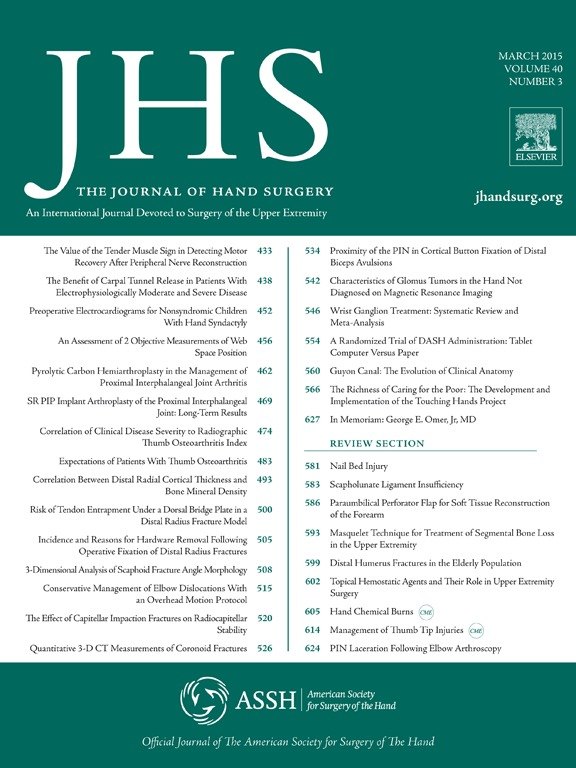
Faster recovery from basal thumb arthroplasty with bone tunnel creation

Faster recovery from basal thumb arthroplasty with bone tunnel creation
Comparison of arthroplasties with or without bone tunnel creation for thumb Basal joint arthritis: a randomized controlled trial
J Hand Surg Am. 2014 Sep;39(9):1692-8Synopsis
79 women aged 40 years and older diagnosed with severe stage IV osteoarthritis (OA) were randomly assigned to undergo ligament reconstruction and tendon interposition (LRTI) of the basal thumb joint using either the Burton-Pellegrini (BP) or the Weilby technique. The BP technique uses a bone tunnel at the base of the thumb, while the Weilby technique does not. The purpose of this study was to compare the short- and long-term pain and physical function outcomes of both techniques. Findings suggested the BP technique prompted faster recovery than the Weilby technique, with better clinical outcome at 3 months. Outcome at 12 months was not significantly different between groups.
Was the allocation sequence adequately generated?
Was allocation adequately concealed?
Blinding Treatment Providers: Was knowledge of the allocated interventions adequately prevented?
Blinding Outcome Assessors: Was knowledge of the allocated interventions adequately prevented?
Blinding Patients: Was knowledge of the allocated interventions adequately prevented?
Was loss to follow-up (missing outcome data) infrequent?
Are reports of the study free of suggestion of selective outcome reporting?
Were outcomes objective, patient-important and assessed in a manner to limit bias (ie. duplicate assessors, Independent assessors)?
Was the sample size sufficiently large to assure a balance of prognosis and sufficiently large number of outcome events?
Was investigator expertise/experience with both treatment and control techniques likely the same (ie.were criteria for surgeon participation/expertise provided)?
Yes = 1
Uncertain = 0.5
Not Relevant = 0
No = 0
The Reporting Criteria Assessment evaluates the transparency with which authors report the methodological and trial characteristics of the trial within the publication. The assessment is divided into five categories which are presented below.
4/4
Randomization
3/4
Outcome Measurements
4/4
Inclusion / Exclusion
4/4
Therapy Description
4/4
Statistics
Detsky AS, Naylor CD, O'Rourke K, McGeer AJ, L'Abbé KA. J Clin Epidemiol. 1992;45:255-65
The Fragility Index is a tool that aids in the interpretation of significant findings, providing a measure of strength for a result. The Fragility Index represents the number of consecutive events that need to be added to a dichotomous outcome to make the finding no longer significant. A small number represents a weaker finding and a large number represents a stronger finding.
Why was this study needed now?
Major impairment can ensue in patients suffering from osteoarthritis (OA) at the base of the thumb, particularly in patients with stage IV OA, due to further cartilage and ligament damage in addition to metacarpal subluxation. Ligament reconstruction and tendon interposition (LRTI) has been speculated to provide effective treatment of stage IV OA. Several techniques using different tendon grafts can be performed, such as the Burton-Pellegrini (BP) (bone tunnel) and the Weilby (without bone tunnel) techniques, but comparative studies are limited. This study aimed to compare pain, physical function, and complication outcomes between the two techniques.
What was the principal research question?
In the treatment of basal thumb osteoarthritis, how does arthroplasty with and without the use of a bone tunnel at the base of the first metacarpal compare in women with stage IV osteoarthritis at 12 months postoperative?
What were the important findings?
- Within-group comparisons of preoperative measurements at 3 and 12 months demonstrated significant improvement in both groups for PRWHE-pain (p<0.001), PRQHE-activities (p<0.001), PRWHE-total (p<0.001) and DASH (p<0.003).
- Patients in the bone tunnel group experienced significantly superior PRWHE-pain (p=0.02) and PRWHE-total (p=0.03) score compared with the no bone tunnel group, but PRWHE-activities (p=0.10) and DASH (p=0.08) did not differ significantly between groups at 3 months postoperative.
- Pain and physical function outcomes measured using PRWHE and DASH were not significantly different between groups at 12 months postoperative (p>0.05).
- Carpometacarpal extension was significantly superior in the no bone tunnel group than the bone tunnel group at 12 months postoperative (p=0.001).
- All other range of motion measurements, grip strength, complications, patient satisfaction, time to return to work/activities, and proximal migration outcomes did not differ significantly between groups at 3 and 12 months postoperative (all p>0.05).
What should I remember most?
Pain and physical function outcomes were significantly improved at 3 and 12 months postoperative regardless of arthroplasty technique, however patients in the bone tunnel group achieved significantly superior PRWHE-pain and PRWHE-total scores than patients in the no bone tunnel group at 3 months postoperatively. The no bone tunnel group experienced significantly greater carpometacarpal extension compared with the bone tunnel group at 12 months postoperatively.
How will this affect the care of my patients?
Results from this study indicate a preference towards the Burton-Pellegrini (bone tunnel) technique to the Wieilby technique (no bone tunnel) in the treatment of stage IV osteoarthritis because of its superior pain and physical function outcomes in the short term, suggesting faster recovery can be achieved with the use of a bone tunnel. This study included a relatively homogeneous study group of women with IV osteoarthritis, so these results should not be assumed for the male population or less severe grades of osteoarthritis.
Learn about our AI Driven
High Impact Search Feature
Our AI driven High Impact metric calculates the impact an article will have by considering both the publishing journal and the content of the article itself. Built using the latest advances in natural language processing, OE High Impact predicts an article’s future number of citations better than impact factor alone.
Continue



 LOGIN
LOGIN

Join the Conversation
Please Login or Join to leave comments.
Orthopaedic Surgeon - Australia
I assume that you meant Flexor Carpi Radialis when you mention Flexor carpi ulnar is multiple times as the tendon used for the reconstruction?